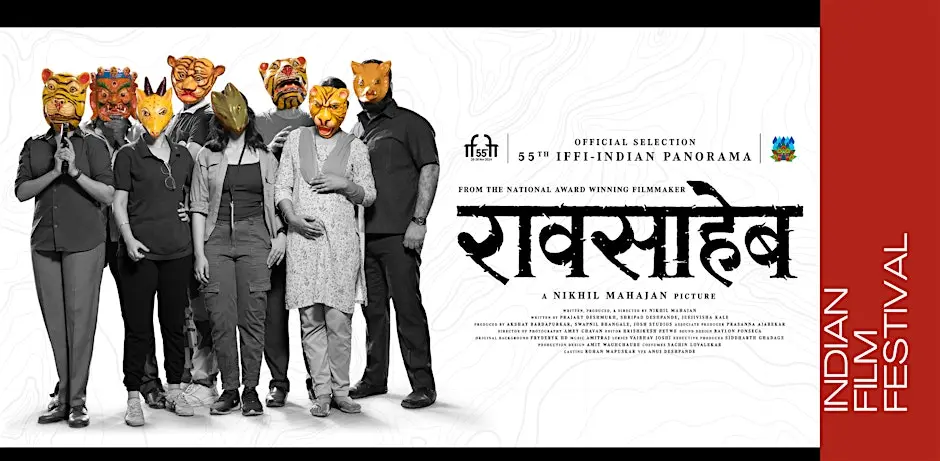An Ode To The Tiger
निर्वनो वध्यते व्याघ्रो निर्व्याघ्रं छिद्यते वनम्।
तस्माद्व्याघ्रो वनं रक्षेद्वयं व्याघ्रं च पालयेत् ॥
The Tiger dies without the Forest, and the Forest is cut down without the Tiger.
Hence the Tiger should protect the forest, and the Forest should defend the Tiger.
– Mahabharata, Udyoga Parva

Yesterday I attended the premier of the Marathi movie “Raavsaheb” at the Indian Film Festival Germany1. The Neo-noir thriller explores the conflict through the eyes of the people fighting a system designed to harm the environment. The film is set in heartlands of Vidarbha2. A region as large as Iceland, it houses all the 500+ tigers in Maharasthra along with most of the mineral resources of the richest state in India.
Raavsaheb (“His Majesty”) is the name of the majestic tiger whose territory is adjacent to the village near the buffer zone. The film doesn’t drag heels and we are thrown in the mix right at the outset where a tribal is killed by a tiger. The tribals and the NGOs that support them are furious and want to eliminate this man-eater. But is it a man-eater tiger? retorts the intrepid forest officer, because the tiger did not eat it’s victim. Officer Kantaar3 Lanjevar who knows these jungles well, suspects that the tiger might have mistaken the human for a deer in the darkness.
Another NGO on the side of tiger conservation are also not amused. Why did the tribal sneak into the core tiger zone forbidden for humans? If it wasn’t for the greed of Mahua4, the man would still be alive, they claim. The mining company who wants the tiger gone so that they can expand their operations, are also in the fray. The honest police commissioner clashes with the mining company which is happily bending the laws. If that wasn’t all, the innocent migrant laborers aren’t spared from brutal exploitation. A celebrity reporter on a tour and innocent kids also get entangled into this Kafkaesque tango between humans and nature.
As the dark clouds gather, the viewer can’t shake a sense of a dark foreboding. In an extremely powerful single-shot scene we feel the greed and inhumanity in full force. I noticed that the whole theater was at the edge of their seats squirming, watching the scenes unfold. The mining company is a faceless corporate entity that cares only about it’s profit, but will the humans lose their humanity in this jungle and become worse than the animals? The rest of the film tries to probe the answers while things escalate beyond violence and sanity.
Curiously we meet Raavsaheb, the elusive tiger only once. As the humans bicker and fight, the majestic animal casually passes them by, treating them as insignificant as rats. This sublime scene made me acutely aware of how we have mistreated nature by arrogantly posing as its Gods.
Jitendra Joshi has done a phenomenal role of Forest Officer Lanjewar. Officer Lanjewar possesses an intimate understanding of the jungle’s rhythms and the ways of the tigers. His performance is superb - effortless yet intense, with masterful restraint in the tense scenes. Mukta Barve delivers a flawless performance as an honest police officer operating outside her usual jurisdiction. The supporting cast of Mrunmayee Deshpande, Mohit Takalkar, Sonalee Kulkarni and debutante Rashmi Agdekar are perfect in their roles. I was surprised by cold, sinister antagonists played by Saagar Deshmukh and Priyadarshan Jadhav. They effectively hide their evil motives behind their clean images.
Director Nikhil Mahajan knows how to craft a narrative around complex and liminal spaces. A winner of the prestigious National Award, he creates a world seldom seen by many outside this region. He deftly bases the film in the rustic Varhadi dialect which is rare to see in Marathi movies. The use of the rich vocabulary and distinct sounds of Varhadi adds to the brilliant soundscapes of the film. The clever use of forest sounds, Spanish vocals and even a cleverly placed Tamil song works wonders. The actors use silence to convey their emotions masterfully, like during a tense confrontation between the local wannabe politician and the forest officer.
There is a poignant scene where Officer Lanjewar prays to the forest deity Waghoba5 before going deep into the core forest to confirm the alibi of Raavsaheb. In this scene, the director skillfully connects the audience with the protagonist’s quest to prove the innocence of Mother Nature.
This, is cinema at it’s finest.
***
-
https://www.berlin.de/en/events/film-festivals/9377623-7812887-indian-film-festival.en.html ↩︎
-
Kantār means dense forest in Sanskrit. Perfect allegory. ↩︎
-
The word “Vidarbha” is the combination of the Sanskrit words “vi” (meaning “special” or “excellent”) and “darbha” (Desmostachya bipinnata, a sacred grass), referring to the abundance of this sacred prairie grasslands in the region. The grass also makes a perfect camouflage for tigers, hence the tiger stripes. ↩︎
-
https://en.wikipedia.org/wiki/Madhuca_longifolia#Mahura_flowers ↩︎